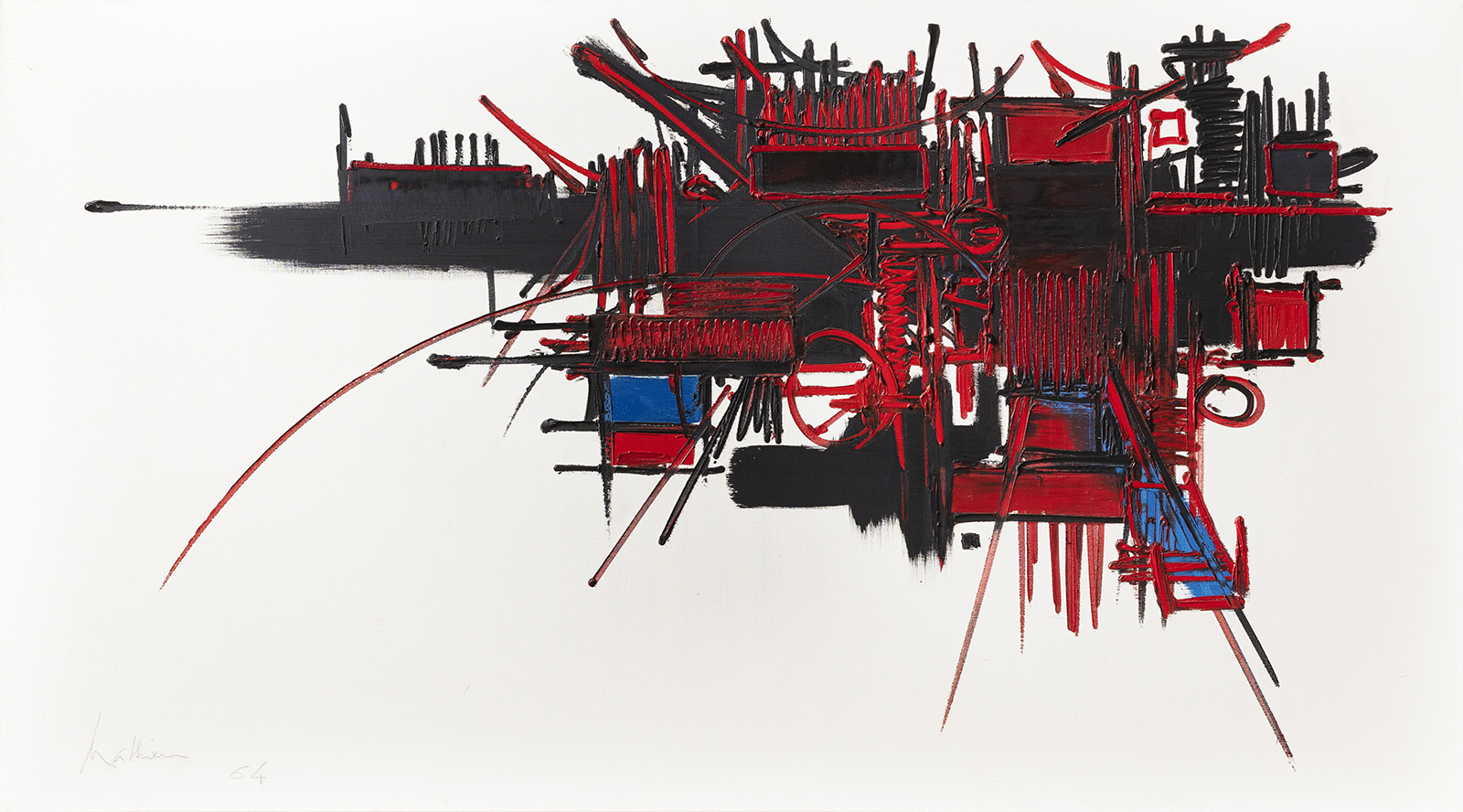GEORGES MATHIEU
乔治.马修
A pivotal figure in Art Informel, and one of the founders of Lyrical Abstraction, Georges Mathieu (1921–2012) pioneered a form of gestural abstraction that was close to performance. A famed-provocateur, he developed a form of painting
where speed and spontaneity are key, creating works using long brushes and applying paint directly from tubes onto the canvas. He brought a new kind of freedom to the creative gesture and gave birth to a brand new style, somewhere
between esoteric sign, calligraphy and raw energy.
Mathieu’s lyrical expression and captivating live painting performances left a mark on artists, critics and collectors for generations to come.
Mathieu’s lyrical expression and captivating live painting performances left a mark on artists, critics and collectors for generations to come.

Georges Mathieu
Labrador1959
Oil on canvas
89 x 146 cm | 35 x 57.5 in
Georges Mathieu
Hommage à Vivaldi1970
Acrylic on canvas
97 x 162 cm | 38.2 x 63.8 in
Georges Mathieu
Inana1958
Oil on canvas
81 x 150 cm | 31.9 x 59.1 in

Georges Mathieu painting. Photo by Dmitri Kessel//Time Life Pictures/Getty Images. © Comité Georges Mathieu / ADAGP, Paris – SACK, Seoul, 2021.
It is this liberty with respect to references which introduces both improvisation, and thereby speed. Speed therefore signifies the definitive abandonment of the artisanal methods in painting in favor of methods of pure creation. Now, is that not the
mission of the artist: to create, not to recopy. Speed and improvisation are the reasons we are able to associate the creative forms of this painting with those of liberated and direct musical forms like Jazz or with Oriental calligraphy.
Georges Mathieu
Li Duan1967
Oil on canvas
81 x 100 cm | 31.9 x 39.4 in
Georges Mathieu
Huisne1969
Oil on canvas
65 x 100 cm | 25.6 x 39.4 in
I wanted to confront the most advanced aspects of expression, knowledge and thought on both sides of the Atlantic.

Georges Mathieu painting La Rentrée triomphale de Go Daïgo à Kyoto (currently in the collection of the Fondation Gandur pour l’Art), in the garden of Tarō Okamoto, Geijutsu Shinchō, vol. 8, 1957. © Comité Georges Mathieu / ADAGP, Paris
– SACK, Seoul, 2021.
Georges Mathieu
Trigaudin1970
Oil on canvas
97 x 195 cm | 38.2 x 76.8 in
Georges Mathieu
Nantouillet II1986
Oil on canvas
60 x 180 cm | 23.6 x 70.9 in
Georges Mathieu
Cardamine1964
Oil on canvas
73 x 130 cm | 28.7 x 51.2 in

Georges Mathieu painting Les Capétiens partout ! in Saint-Germain-en-Laye, 10 October 1954. © Comité Georges Mathieu / ADAGP, Paris – SACK, Seoul, 2021.
Georges Mathieu painting Les Capétiens partout ! in Saint-Germain-en-Laye, 10 October 1954. © Comité Georges Mathieu / ADAGP, Paris – SACK, Seoul, 2021.
I used the most direct means possible to paint: the free play of essence and color, that is to say dripping, sprinkling the canvas with Ripolin poured from a certain height right from the box.
Georges Mathieu
Déformation de fonction variable convexe1957
Oil on canvas
97 x 162 cm | 38.2 x 63.8 in

Georges Mathieu and Michel Tapié at the Rive Droite Gallery, 1954
Georges Mathieu
Untitled1958
Ink on cardboard
51 x 73 cm | 20.1 x 28.7 in

© Comité Georges Mathieu, ADAGP
© Comité Georges Mathieu, ADAGP
Georges Mathieu's work has been the subject of numerous retrospectives, and is in more than eighty museums and public permanent collections, including the Art Institute of Chicago; Centre Pompidou, Paris; the Hirshhorn Museum and Sculpture Garden, Washington,
DC; Kunstmuseum Basel; Kunsthaus Zürich; the Museum of Contemporary Art, Los Angeles; the Museum of Fine Arts, Houston; the Museum of Modern Art, New York; the Musée National d'Art Moderne, Paris; the Solomon R. Guggenheim Museum,
New York; and the Tate, London.









